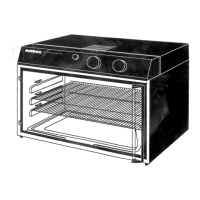Baking Tips
General Temperature Guidelines fer Oven Baking*
. Cakes -- 300 ° (Rich, den_ cakes, such as chocolate, cheese
or fruit cakes, may require additional baking time and a 275 °
temperature setting.)
° Yeast breads --300 ° m 325 °
-Cookies- 3_ ° to 325 °
. Pies -- 350 ° to 400 ° (Although pies brown iSster than in a
conventionN oven, do not remove tile pie before _e cooking
time is up. _e browning action will "slow down" while the
filling and bottom crest cooks. If edges of crest are getting mo
brown, make a collar of aluminum foil and secure around edge
m prevent t)rther brnwning).
Baked Potatoes _ 350 ° m 400 °
Casseroles _ Follow conventional oven temperatures in
your recipe.
, Refrigeratorffrozen convenience foods -- Follow conventional
oven temperatnre instructions on p_kage.
For Mgh-Mtitnde baking: Make the regular oven adjustment
of lowering temperature 75° (but not below 300°). Above 3(_3
feet, cakes may fall or have a coarse texture. To avoid this,
d_rease the amount of leavemng and alter fat and sugar. For
recipes containing 2 cups of flour, decrease sugar by 2½ tbls.
and baking powder by ½ tsp. Increase liquid ½ m 1 tNs. When
making angel f_ and sponge cakes, do not beat mo much a_
into the eggs. Use egg whites at room temperatt_e. Beat only
until they form a _ that falls over, not stiff and dry. Do not
underb_e. Baking temNmture guidelines, as shown above, are
_proximate and should be used only as a guide. Test _br
doneness by using a cake tester.
*Genera! cooking guidelhles m_eshown on the oven co\,atrol panel
I0
You may use all ),our favorite metal baking pans and dishes.
For the best baking results, use aluminum or black pans_ Shiny
aluminum pans reflect heat and are reco to produce ligb&
tender crusts. Black pans absorb heat _d are recommended to
produce brown, crisp crests. The outside finish of the pan affects
cooking and baking performaxtce more than the inside finish. It you
use a glass pie pan or baking dish, place it on a metal cookie sheet
in the oven tor better heat distribution.
Use standard-size cake. loaf. Bundt and pie pans. Suggested sizes
for other pans include:
, Jellyroll pan 15 l/2x 10 I/2x 1 inches
, Baking pan 13 x 9 x 2 inches
- Cookie sheet 14 x 9 inches
- Cake pans two 8-inch cake pans fit on one rack.
Roasting Tips (See chart on page 14)
Roasting time will depend on the shape of the meat: a long
thin roast will cook faster th_ a shorn thick one, even though the
weights are the same. Use the roasting ch_ as a general gtfide.
Cooking tLmes are approximate.
To check meat doneness, use a meat th . Push the
thermometer into the thickest part of the meat. Be sure it does not
touch any bone or fat pocket. Many meats continue to cook after
being removedfivm the oven. especially beel; whose inwrnal
temperature rmdyincrease about 10 °. After removing meat_ora
oven, allow it to stamljbr 15 to 20 minutes to permit this add#ional
cooking andJbr easier carving.
No basting is required when roasting. Roasts are juicier because a
convection oven retains moisture. This added moisture gives a self-
basting quality m your masting.

